Table of contents
Celeriac ( Apium graveolens var. rapaceum) is a cultivated form of wild celery, where the root (bulb) is mainly consumed, but the green leaves are also edible. Celeriac ( organic) can also be prepared raw.
Use in the kitchen
The root of celeriac is round to turnip-shaped and can reach a weight of up to 1 kg. The skin is yellowish-white to grey-brown and has a warty appearance. The flesh is white to beige, firm and fibrous. Celeriac (root celery, celeriac) tastes spicy and somewhat bitter due to the essential oils it contains. The older the root vegetable, the more intense the taste.
Traditionally, the typical winter vegetable is used cooked as a vegetable ingredient in hearty soups, braised dishes, stews, casseroles and sauces (e.g. in vegan gravy, vegan Bolognese). Celeriac also tastes great as a side dish or in a mixed vegetable pan. Celeriac can be used with potatoes to make a wonderful puree. You can also bake it whole in the oven or make "fries" out of it. For a popular recipe, celeriac can be used to make vegan schnitzels (breaded).
Can you eat celeriac raw? You can eat celery raw - this is how the aroma of the celery root really comes into its own. Celeriac root is enjoyed raw in a variety of salads, e.g. with carrots. It tastes particularly delicious combined with fruit such as apples, pears, pineapples, tangerines, grapes - and also in juices and smoothies. Celery sticks can also be eaten raw.
Do you have to peel celeriac? The outer skin of the celery root is often hard, so you remove it before cooking. This is not necessary for young root vegetables or for sauces, soups or stocks. Especially with organic quality, you should brush well under running water or in water. Peeled root vegetables discolor quickly. You can avoid this by sprinkling the raw celery root with lemon juice and adding vinegar or lemon juice to the cooking water.
Raw celeriac leaves, which resemble those of parsley, can be used to season dishes.
Vegan recipe for Waldorf salad with celeriac
Ingredients (for 4 people): ½ celeriac (raw, organic), 2 apples, 2 tangerines, 20 g walnuts, 1 tsp lemon juice, 2 tbsp vegan mayonnaise, 2 tbsp vegan sour cream, 5 tbsp vegan cream (e.g. oat cream), a little salt andpepper.
Preparation: Peel and halve the celery root. Wash the apples, quarter them and remove the core. Grate the celeriac and apples coarsely into a salad bowl using a vegetable grater. Add a few drops of lemon juice to prevent them from turning brown. Roughly chop the walnuts. Peel the mandarins and separate the fruit slices. For the dressing, mix the vegan mayonnaise, vegan sour cream and vegan cream and season with a little salt and pepper. Pour the dressing over the celeriac and apples. Add the walnuts and mandarins and serve the vegan Waldorf salad.
Vegan recipes with celeriac can be found under the note: " Recipes that have the most of this ingredient ".
| Not only vegans or vegetarians should read this: Vegans often eat unhealthily. Avoidable nutritional errors. |
Purchasing - Storage
Supermarkets such as Coop, Migros, Denner, Volg, Spar, Aldi, Lidl, Rewe, Edeka, Hofer etc. generally offer raw celeriac all year round, often in combination with other vegetables, e.g. packaged as soup vegetables. Organic celery root can also be found in organic supermarkets (e.g. Alnatura, Denn's Biomarkt). You can buy particularly fresh and local celery root at weekly markets.
The availability of celeriac (raw) varies depending on the size of the store, catchment area, etc. Our recorded food prices for the DA-CH countries can be found above under the ingredient image - and by clicking you can see their development at various suppliers.
Found in the wild
The wild form of celery is found worldwide and grows on moist, saline soils on coasts as well as in marshes, swamps, wet meadows and ditches. 1,2 Read more about the risk of confusion below.
Storage tips
Celeriac can be kept in the vegetable compartment of the refrigerator for up to two weeks if stored correctly, i.e. wrapped in a damp cloth. It spoils more quickly if it is stored next to fruit that is ripening. Celeriac itself is not a climacteric plant, so it does not ripen. To freeze it, it is best to cut the celeriac into pieces and pack it in an airtight container. Celeriac can be stored raw in the freezer for up to six months, and cooked and frozen for up to three months.
Fresh celeriac is dry and firm. Signs of decay include dark brown spots and when it gives way when pressed with your finger.
Ingredients - Nutritional values - Calories
Celeriac (raw) has 42 kcal/100g, which makes up 2.1% of a woman's daily energy requirement (2000 kcal, see pictogram nutrient tables). It contains 1.5 g/100g of protein and 1.8 g/100g of fiber. If you compare the percentage coverage of the daily requirement of proteins (3%) and fiber (7.2%) of raw celeriac with the energy content (2.1%), the former are rather excessive. 3 This allows a relatively low-energy and low-fat intake of proteins and fiber, which can also support efforts to reduce weight.
Celery root contains a number of healthy vitamins and nutrients. You consume 41 µg of vitamin K per 100 g, which is 55% of your daily requirement. Red cabbage (38 µg/100g) and Chinese cabbage (43 µg/100g) contain a similar amount of vitamin K. Only chard contains more than 20 times as much, at 830 µg/100g. But phosphorus and potassium also provide 15 and 16% of your daily requirement, respectively, in 100 g of root celery. 3
Celeriac also contains 0.16 mg of vitamin B6 (pyridoxine) per 100 g - that corresponds to 12% of the daily requirement. Kohlrabi (0.15 mg/100g) and carrots (0.14 mg/100g) have similar contents. At 1.7 mg/100g, pistachios (raw) contain particularly high levels of vitamin B6. 3
The vitamin C (ascorbic acid) content in celery root is 8 mg/100g (10% of the daily requirement). This is similar to that of rhubarb (8 mg/100g) and shallots (8 mg/100g). Significantly more vitamin C can be found in yellow bell peppers (184 mg/100g). 3
You can find all the ingredients of celeriac, the coverage of the daily requirement and comparison values with other ingredients in our nutrient tables. In the article Nutrients explained you will get a detailed insight into the topic.
Effects on health
Is celeriac healthy? Since celery root, like celery in general, is low in calories, the vegetable is recommended as part of a change in diet for the treatment of obesity - and thus for weight loss. Secondary plant substances in celeriac (such as phenolic acids, flavones, flavonols and antioxidants) can help to lower cholesterol levels, blood pressure and blood sugar levels. This makes celery root also suitable for diabetics. 4,5
In addition, celery can be used to prevent cardiovascular diseases, jaundice, liver disease, gout and rheumatic diseases. Celery is also said to have antifungal, antibacterial, anti-inflammatory and antioxidant properties. Celery seeds also have medicinal uses, such as treating bronchitis, asthenopia, asthma, vomiting and fever. 6 Bioactive compounds called phthalides, which are found in celery, are also said to protect against cancer. 7
Celery contains bioactive substances that can provide relief from some complaints. Edema, kidney stones and gout can be treated with the diuretic effect of the essential oils. Excess acids in the body can be neutralized with the alkaline mineral salts in celery. The psoralens contained in celery are active ingredients that can cause increased sensitivity to light in some people. 4 On the other hand, these psoralens can also protect the skin in special therapies for skin diseases (eg psoriasis vulgaris), which would otherwise be affected by very itchy inflammations. 15
Dangers - Intolerances - Side effects
Is raw celery poisonous? Celery is very tasty and non-poisonous when raw, but it is one of the 14 main allergens. It must therefore be labelled in the EU. 8 Combined allergies to celery and birch or mugwort pollen often occur (e.g. birch-mugwort-celery syndrome or celery-carrot-mugwort-spice syndrome). Possible allergic reactions to celery range from mild, local reactions in the oral cavity to severe, systemic reactions (e.g. anaphylactic shock). Since celery allergens have largely proven to be heat-resistant, people who are sensitive to celery should generally avoid celery products. 9
The above-mentioned psoralens are heat-stable, phototoxic plant substances that belong to the furocoumarins. If you eat large portions of vegetables that contain furocoumarins, such as parsnips, parsley or celery (e.g. 450 g cooked), sensitive skin can experience acute phototoxic reactions after exposure to sunlight. Inflammation with itching and redness follows. The levels of such natural ingredients vary greatly, which is why no clear consumption recommendations can be made. 16 For a long time, it was assumed that only celery infected with the fungal parasite "pink-red" triggers these reactions, as the infection induces an increased production of furocoumarins. However, it is now known that celery that has been bred to be resistant to this fungal infection also has an increased level of these furocoumarins. 10
Danger of confusion
The appearance and smell of celery are similar to water hemlock (poisonous water hemlock, Cicuta virosa) and the yellow vine umbel (saffron umbel, poisonous vine umbel, Oenanthe crocata); both are also members of the Umbelliferae family. Celery should not be confused with these plants, as both are poisonous. 8
Folk medicine - natural medicine
In folk medicine, celery is often used as a salad or freshly squeezed juice to stimulate the appetite, aid digestion and excrete. Celery tea is recommended for nervous weakness, chronic lung diseases, rheumatism and gout. 1
In traditional Chinese medicine ( TCM), celery is used as a remedy for high blood pressure. 11
In the Middle Ages, people believed that it had an aphrodisiac and potency-enhancing effect. Some people are still convinced of this today. However, this effect has not been proven. 2.8
Ecological footprint - animal welfare
Vegetables generally have a better carbon footprint than animal products and among vegetables, root vegetables have a particularly good ecological balance. 22 The carbon footprint of celery available in Germany is 0.2 kg CO 2 eq/kg. 19 According to its calculations, a Danish survey found that celeriac had a carbon footprint of 0.33 kg CO 2 eq/kg, with agriculture accounting for the largest share (alongside land use change, processing, transport, packaging and trade). 23
We could not find an exact calculation of the water footprint of celeriac. To give you a rough idea: the global average water footprint (WF) of vegetables is 322 l/kg (green, blue and grey water). Root vegetables have a WF of 387 l/kg, but this value is mainly made up of rainwater; the WF/kcal ratio is also better compared to the average vegetable. 20
In 2009, the FiBL ( Research Institute of Organic Agriculture) conducted life cycle analyses (LCAs) of various organic products in Austria. The researchers compared these LCAs with the conventional equivalents. Organic vegetables caused 10-35% less CO 2 emissions (based on 1 kg of product). 21
Although pesticides bring benefits to agriculture, the negative consequences for the environment must be taken into account. Pesticides often accumulate in nature or are difficult to break down. They directly and indirectly pollute air, water, soil and entire ecosystems. As a result, they pose a threat to the health of all living things. 25
The use of chemical-synthetic agents and pesticides is prohibited in organic farming. 24 Therefore, if possible, choose organic celeriac.
For detailed explanations of various sustainability indicators (such as ecological footprint, CO2 footprint, water footprint), see our article: What does the ecological footprint mean?
Worldwide occurrence - cultivation
Celeriac is one of the oldest root vegetables in history. Ancient Egyptians, Romans and Greeks used it for medicinal and religious purposes. In the Middle Ages, celeriac gained culinary importance. It was first mentioned as a kitchen ingredient in the 17th century, in France. Celeriac is still a popular winter vegetable throughout Europe. 12
Cultivation in the garden
Young celeriac plants should be grown in a warm greenhouse or on a windowsill. If you start sowing the seeds in March, the cultivation takes about six to eight weeks. When the seedlings are big enough, you can prick them out and plant them in larger pots or boxes. As soon as the young plants have well-rooted and there are no more late frosts, you can plant them outside in the bed. 13
Root celery is a heavy feeder that requires humus-rich loamy soil, but with enough sand. The soil should be moist and well loosened. You can add a little compost before planting. Plant the young plants as high as possible in the soil (approximately the same height as the plants were in the nursery bed). This promotes good tuber development. The soil should be loosened regularly during cultivation and the plants need a lot of water, especially from mid-August to early October. The tubers can be harvested from October onwards. 13
For early harvests (end of May), celeriac is grown in a greenhouse with sowing in January. For summer and autumn harvests, early plants are planted outdoors between the Ice Saints (mid-May) and the end of June. Producers can regulate the size of the celery root by planting at the right time. Yields can reach 30-35 tons per hectare. 14
Further information
The cultivated form of celeriac ( Apium graveolens var. rapaceum) is a variety of the common celery ( Apium graveolens), as are celery ( Apium graveolens var. dulce) and cut celery ( Apium graveolens var. secalinum). The genus celery ( Apium) belongs to the family of the Umbelliferae (Apiaceae) and is derived from the wild form 'wild celery' ( Apium graveolens var. graveolens 17). The root vegetable is related to carrots, fennel, caraway, parsnips and root parsley. The last two are not only botanically very similar to celeriac, but also in terms of taste. 2
Celeriac develops a semi-underground storage organ that involves the main root, hypocotyl and compressed stem. This means that it is actually a turnip. However, since the largest part of the storage body falls on the stem section, the term tuber is not entirely incorrect. 18
In addition to root celery, the two varieties of celery and cut celery are important in cooking. With celery, the sticks are mainly eaten, while with cut celery, the leaves and stalks are eaten.
Alternative names
Celeriac is also called root celery (celery root), knob celery, Zeller, Merk or Eppich (generally for celery). Incorrect spellings such as celeriac, celeriac vegetables, celeriac, celeriac root, celery root, celery root seleri ...
The Duden dictionary states that celery can be used in both the masculine and feminine form. Therefore, "der Sellerie" is correct, but so is "die Sellerie".
In English, celeriac is known as celeriac, celery root, knob celery or turnip-rooted celery. In Spanish, bulbo de apio means celery bulb and apionabo (apio nabo) means celery. In French, the terms céleri-rave, céleri-navet and céleri pansu are known (céleri racine is a search combination, but not a correct name).
Bibliography - 25 Sources
| 1. | Pahlow M. Das grosse Buch der Heilpflanzen. Gesund durch die Heilkräfte der Natur. Nikol Verlagsges. mbH: Hamburg; 2013: 290-291. |
| 2. | Biothemen.de Sellerie - Stange, Knolle, Blatt - eine kleine Warenkunde. |
| 3. | USDA United States Department of Agriculture. |
| 4. | Roger JDP. Heilkräfte der Nahrung. Advent-Verlag: Zürich. 2006: 232-233. |
| 5. | Hedayati N, Bemani Naeini M, Mohammadinejad A, Mohajeri SA. Beneficial effects of celery (Apium graveolens) on metabolic syndrome: A review of the existing evidences. Phytother Res. 2019;33(12):3040–53. |
| 6. | Kooti W, Daraei N. A review of the antioxidant activity of celery (Apium graveolens L). J Evid Based Complementary Altern Med. 2017;22(4):1029–34. |
| 7. | Sowbhagya HB. Chemistry, technology, and nutraceutical functions of celery (Apium graveolens L.): an overview. Crit Rev Food Sci Nutr. 2014;54(3):389–98. |
| 8. | Pini U. Das Bio-Food Handbuch. Ullmann Verlag: Potsdam; 2014: 679-680. |
| 9. | Farrp.unl.edu Allergenic Foods and their Allergens, with links to Informall - Vegetables. |
| 10. | Deleo VA. Photocontact dermatitis. Dermatologic Therapy. 2004;17(4):279–88. |
| 11. | Eurapon.de Sellerie: Viel mehr als ein Suppengemüse. |
| 12. | Ucanr.edu Celeriac (Celery Root) - Apium graveolens var. rapaceum. |
| 13. | Mein-schoener-garten.de Knollensellerie. |
| 14. | Sachweh U (Herausgeber). Der Gärtner, Band 3, Baumschule, Obstbau, Samenbau, Gemüsebau. 2. Auflage, Ulmer: Stuttgart. 1986/1989: 222 f. |
| 15. | Aryee-Boi J. Dusch-PUVA : Ein innovatives Verfahren der lokalen PUVA-Therapie. Klinische und pharmakokinetische Ergebnisse bei Psoriasis vulgaris. Dissertation. Freie Universität Berlin. 2002. |
| 16. | BfR Bundesinstitut für Risikobewertung. Zwischen gesund und giftig - Pflanzeninhaltsstoffe auf dem Prüfstand. 12/2007. |
| 17. | Ex-situ-erhaltung.de Verband Botanischer Gärten. Portal für Erhaltungskulturen einheimischer Wildpflanzen. Apium graveolens subsp. graveolens (Wilder Sellerie). 2022. |
| 18. | Lieberei R, Reisdorff Ch. Nutzpflanzenkunde. Georg Thieme Verlag KG: Stuttgart. 2007. |
| 19. | Reinhardt G, Gärtner S, Wagner T. Ökologische Fussabdrücke von Lebensmitteln und Gerichten in Deutschland. Institut für Energie - und Umweltforschung Heidelberg. 2020. |
| 20. | Mekonnen MM, Hoekstra AY. The green, blue and grey water footprint of crops and derived crop products. Hydrol. Earth Syst. Sci. 2011; 15: 1577-1600. |
| 21. | FiBL Österreich. CO2-Fussabdruck von Bioprodukten. Ergebnisse Gemüse. 2009. |
| 22. | Poore J, Nemecek T. Reducing food’s environmental impacts through producers and consumers. Science. Juni 2018;360(6392):987–992. |
| 23. | CONCITO. Denmark's Green Think Tank. The big Climate Database Version 1.1. Celery root. 2024. |
| 24. | Braun PC. Die Zukunft der Landwirtschaft ist biologisch! : Welthunger, Agrarpolitik und Menschenrechte. Verlag Barbara Budrich; 2009. 296 S. |
| 25. | Sharma A, Kumar V, Shazad B et al. Worldwide pesticide usage and its impacts on ecosystem. Springer Nature Applied Sciences. 2019. |

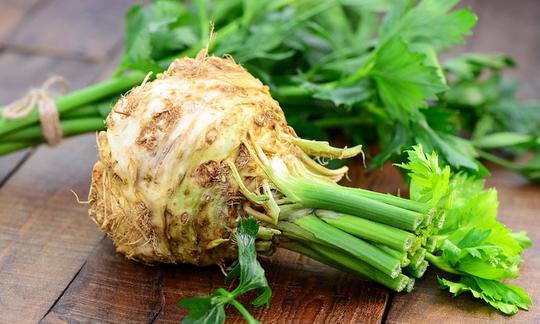

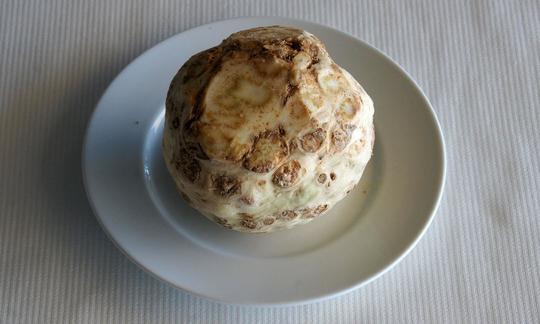

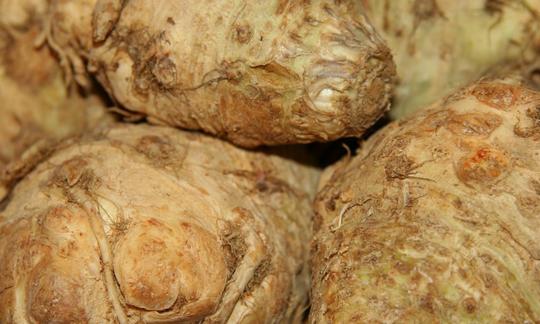

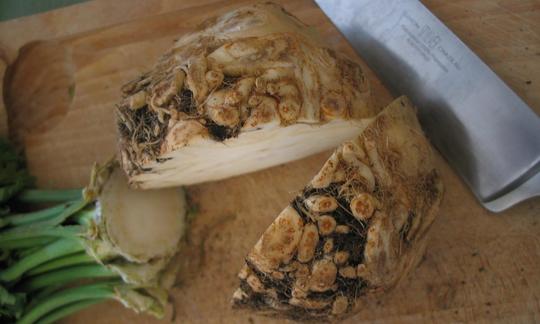


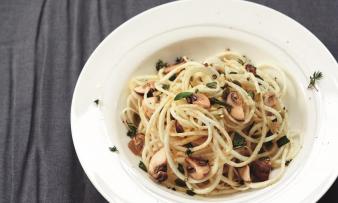
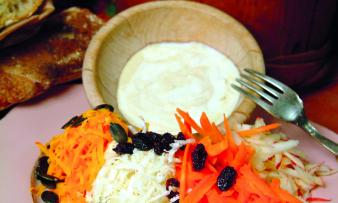

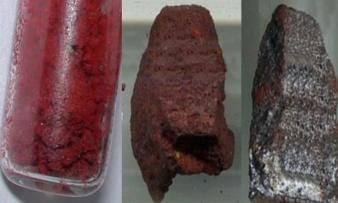



Comments